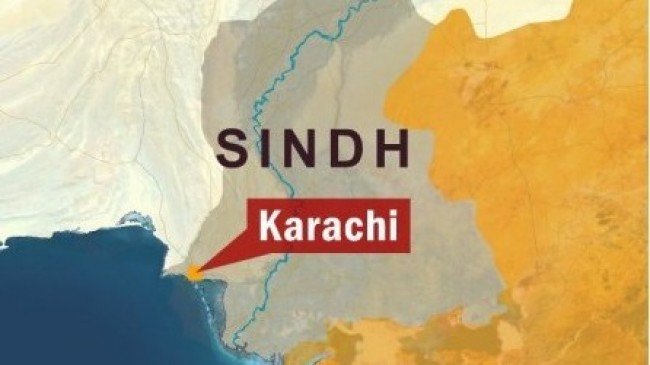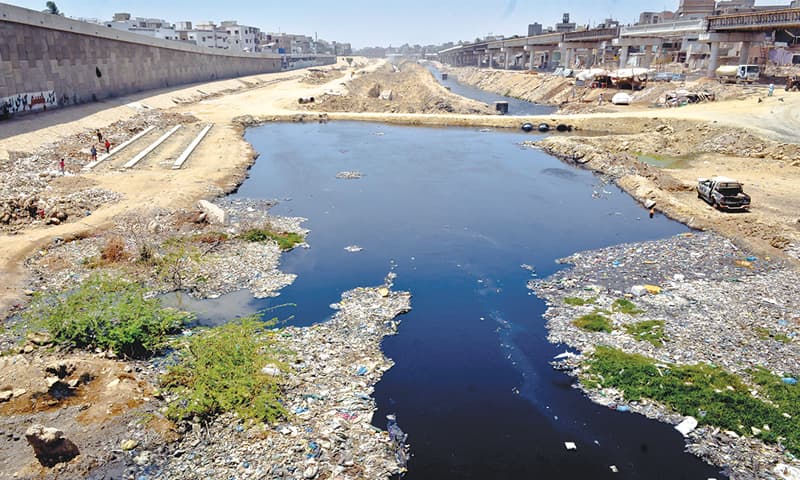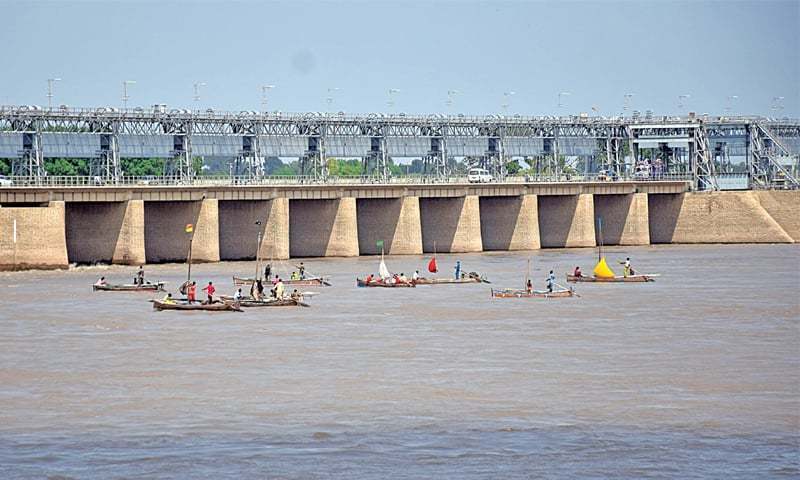
[From imperial ‘unhappy valley’, to decapitated province, commercial capital, and 21st century megacity, this article reflects on relations of separateness and connectivity between Sindh and its capital city Karachi. These culminated in Pakistan’s post-Independence years, in official and political language, governances of national, provincial and city division, and political rhetoric and violence. The article asks what else might be uncovered about their relationship other than customary alignments and partitions between an alien urban behemoth and a provincial periphery. It develops a topographical view to refer to the physical arrangement of environments but also people’s profane, spiritual and political connections and losses involving place and dwelling]
By Nichola Khan
Water: Appropriation, flood, and overflow
Topographically speaking, might we next draw a wider cartography of urban living through maritime, watery or amphibious relations in order to contextualize the political conditions of governance and affectations that shape Sindh’s relation to Karachi, the Indus, and Arabian Sea region? Might this vocabulary produce critical thought around the human geography of the city-province divide, and its colonial and postcolonial connections? If the city and its borders are an exercise in fluidity, should they not also address geographies that are literally fluid and circulatory? Here I address the tendency of social and political geographies to assume the vantage-point of the enclosed, terrestrial nation without reflecting on how urban maritime, riparian and fluvial landscapes shape social borders. Sugata Bose (2006) reflects on forms of belonging in aquatic and extra-terrestrial borderlands. Mapping the inter-regional arena of the Indian Ocean as a radical space for understanding identity and society beyond continental or national identifications, he conceives shared water rims as places for political and personal affinity, new frontiers, cultural borderlands, and imaginaria. Correspondingly: the contemporary journey through and with water, the motivation for maritime trade and travel, and the journey through water, ports, and surfaces is a topography that can also offer fresh concepts for citizenry, identity, and rethinking provincial divides.
 Debates about loss of self and the permeability of fragile, fluid borders occur against the enduring backdrop of the Indus, whose inconstant waters are a metaphor for Sindh’s unpredictable undulations. In the interstice between pre-colonial and colonial eras, the promise of the River Syndhu for the British East India Company proved coveted but elusive. Later, the Indus shaped the division of colonial territories into India and Pakistan, and center-province disputes over rights, resources, and self-determination. After Independence Karachi’s civil amenities, inherited from the British, failed to keep a pace with the city’s mutinous growth and burst, flooding the Indus Delta with industrial waste and raw sewage, poisoning the water, mangroves, marine ecology, and propelling the extinction of several marine species (Greenwood, 2010). Karachi’s fermenting waterways have since served as a conduit for violent confrontation, not around foreign invaders, but grievances of immigration, language, ethnicity, and confession centered on the acquisition of local power.
Debates about loss of self and the permeability of fragile, fluid borders occur against the enduring backdrop of the Indus, whose inconstant waters are a metaphor for Sindh’s unpredictable undulations. In the interstice between pre-colonial and colonial eras, the promise of the River Syndhu for the British East India Company proved coveted but elusive. Later, the Indus shaped the division of colonial territories into India and Pakistan, and center-province disputes over rights, resources, and self-determination. After Independence Karachi’s civil amenities, inherited from the British, failed to keep a pace with the city’s mutinous growth and burst, flooding the Indus Delta with industrial waste and raw sewage, poisoning the water, mangroves, marine ecology, and propelling the extinction of several marine species (Greenwood, 2010). Karachi’s fermenting waterways have since served as a conduit for violent confrontation, not around foreign invaders, but grievances of immigration, language, ethnicity, and confession centered on the acquisition of local power.

Regarding interrupted flows and dams built on the Indus designed to bolster Pakistan’s national unity Vis à Vis India, Akhter (2015) deploys a ‘hydraulic lens’ to examine some historical controversies around the Tarbela Dam. He describes how the appeal of Pakistani state nationalism to the ‘natural unity’ of the Indus basin continued Sindh-Punjab hydro-political tensions dating to British rule. The centralized diversion of water to owner-occupier households in Punjab, away from ‘feudal’, ‘unproductive’ tenanted lands downstream in Sindh, resulted in the contradictory production of postcolonial state space as simultaneously integrated and contested. Likewise, drawing on claims of the Indus as central to Sindh’s five thousand year heritage and social, cultural, and economic life, Sindhi autonomist and separatist groups argue that water rights deriving from the Indus belong exclusively to Sindh (Greenwood, 2010). Controversies center on the 1960 Indus Water Treaty between India and Pakistan, the 1945 Sindh-Punjab Draft Water Accord, the construction of the 1955 Kotri and 1962 Guddu barrages, the 1967 Mangla and 1975 Tarbela Dams, the Greater Thal Canal, and the Bhasha Dam in 2018. In October 2018, Sindhi demonstrators from the Indus Delta marched toward Karachi in protest against dams on the Indus, their rural disempowered voices largely ignored by mainstream media (Javed Soomro, BBC World Service, personal communications).

The virtual desiccation of the Indus riverbed below Sukkur in Sindh reduced the Lyari River in Karachi to a stream foetid with uncleaned rubbish, its riverbanks to a scrubby plain for grazing cattle and drying laundry, its residents to lives punctuated by water shortages and electricity outages. These divided central and north Karachi from its wealthier south. After fifteen years delay, the Chinese-funded Lyari expressway finally opened, allowing drivers to speed away from delays and obstructions toward a lucrative new future. Those families who journeyed to Karachi from India no longer gazed tranquilly from their rooftops, but bared their ruined hearth for the relentless appetites of an alien new world, once again seeking new land to settle and call home.
Disputes over water erupted in 2010 when, during the summer monsoon rains, the Indus burst its banks the length of Pakistan, wreaking devastation and propelling the Indus to the fore. According to Pakistan’s National Disaster Management Authority, the floods constituted the worst natural disaster in national history. By September, the NDMA estimated almost 2000 people dead and the numbers of affected population in a country of around 167 million, at around 22 million, including12million needing urgent food aid and humanitarian assistance, and over six million homeless. In Sindh, where a high concentration of districts, communities, villages, settlements and rural poor people the river banks, around 7 million were affected (OCHA, 2010). The 2011 floods again affected Sindh most severely. Amidst condemnation at the institutional apathy and slow government response, state and humanitarian organizations were ill-prepared to deal with communities long-vulnerable to floods, cyclones, and displacement: still, no permanent natural disaster strategy or environmental migration policy exists (Alvarez-Quinones, 2015).
After Partition, Sindh’s Thar Desert, the world’s most densely populated desert, re-shaped new movements between borders and pastoralists, routes through harsh terrain, and regulated im/mobilities between India and Pakistan. Southern Sindh’s drylands and parts of Balochistan now face increasing desertification, land degradation, and worsening drought (SLMP, 2018). Tharparkar, Sindh’s largest district has long experienced droughts, extreme environmental conditions, and extreme food insecurity. These, combined with climate change, poverty, and prolonged government inertia, produced a famine in 2013–2014. Tharparkur, comprising 2300 villages and 1.5m people, was most severely affected; many affectees from Hindu communities migrated to nearby districts seeking work and fodder; many Muslim affectees migrated to Karachi and Hyderabad to work and send remittances (Alvarez-Quinones, 2015). Severe droughts recurred in 2018. The confluence of drought, hunger, and land degradation changed seasonal and forced migrations. These poverty and climate-induced migrations appear far from any image of proud middle-class Sindhi reclamation.
Steinberg and Peters’ (2015: 261) notion of ‘wet ontologies’ provokes thinking about the ‘volumes within which territory is practiced: a world of fluidities where place is forever in formation’. Desertification, dams, and floods visibly nudge the shifting borders of Karachi in Sindh, revealing a larger regional map of shifting geopolitical uncertainties involving Pakistan, India, China, and the US. Locally, given many traumas are collectively shared they also underscore the permanency of Sindh’s citizens unmitigated ties as both familiars and strangers. Given the violent history of the collective embrace, progress will entail, to paraphrase Shah Abdul Latif, swimming upstream. Still, time, caste, and confession are tractable. Sindhis have long embraced highly syncretic cultural and religious forms, sharing rituals, celebrations, shrines, and temples.
Let us travel through, beyond crisis (Khan, 2010), to places where manifold, miscellaneous life trajectories and displacements of compass and direction offer possibilities for capturing new connections, and ways of being, that bypass political bifurcations of native/stranger and self/other. I do not imply people can simply unbound themselves from the violent force of national politics. Rather, I reflect on the potential in the familiarities, confidentialities, and sensibilities emerging from shared crisis. That is, on the possibilities residing in crises of eviction, displacement, and migration within and into the city; in ways people are propelled into new habitations and Karachi is reconstituted as a mêlée of neighborly unfamiliarity, forced proximities, and bodily disorientations.
Notably, in the primary struggle to rest and survive, diverse multiple climate-induced displacements and economic migrations into Karachi do not appear to be reprising earlier forms of dispossession into new political claims drawn around ethnicity, rights, and self-determination. As in other spaces of refuge, agency may indicate efforts ‘to make spaces “ordinary” through processes of squatting and building that seek to reclaim “normal life” and create places of “home”’ (Sanyal, 2014: 570). Therefore: when a politics of rights and antagonisms is devastated from people’s visions of the future, and memory can no longer be invoked to reconnect people disoriented by deluge, desiccation, and dispossession to their suzerain versions of history, might a new urban politics not begin? Might people’s ruptures of attachment and losses of anchorage offer a new experiment to create other ordinary possibilities, landscapes, and entanglements – in reciprocal, mutual collaborations of living and correspondences of earth, spirit, and flesh? Might this become a political practice borne from everyday cohabitation, and foreign urban oscillations that enable unexpected, unsettling practices of caring, and enduring, with each other?
__________________
About the Author
Nichola Khan is a Reader in Anthropology and Psychology, and Director of the Centre for Research in Spatial, Environmental and Cultural Politics at the University of Brighton. She is author of the following books: Mohajir Militancy in Pakistan (2010, Routledge), Cityscapes of Violence in Karachi (ed., 2017 Hurst & Co.,) Mental Disorder: Anthropological Insights (2017, University of Toronto Press) and Arc of the Journeyman: Afghan Migrants in England (in press, University of Minnesota Press). She is currently developing a literary anthropological project on war and migration in twentieth-century Chinese South-East Asia.
Click here for Part-I , Part-II , Part-III